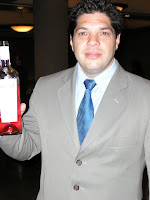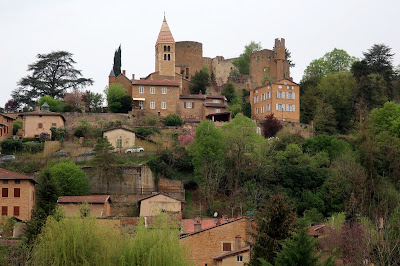Bodega Melipal: Malbec Wines from Argentina
“building a reputation for quality and consistency”
 I talked with Luis Manino, Export Manager for Bodega Melipal of Argentina, when he was in town last week with Doug Reichel Wine Marketing Inc. for Premier Saskatchewan. I learned so much about Argentinian wine and the Melipal Winery.
I talked with Luis Manino, Export Manager for Bodega Melipal of Argentina, when he was in town last week with Doug Reichel Wine Marketing Inc. for Premier Saskatchewan. I learned so much about Argentinian wine and the Melipal Winery.A European Tradition
Argentina has been making wine since the 1600s – not surprising when you learn that 80% of the population is of Spanish and Italian descent. But it was a very basic wine designed to satisfy the local market. Things have changed in the last 20 to 30 years, and Argentina is now one of the top five wine-exporting countries in the world.
“Argentina is all about over-delivering on quality, says Luis. “Our $15 wine can compete with a $30 wine from another country.”
Malbec
Mendoza, one of the principal wine-growing areas, is located at the foot of the Andes, and its wineries are at an average height of 900 metres. The area is a desert with cool, dry air and more than 300 days of sunlight a year. “At Melipal, the harvest extends from mid-January to mid-April,” Luis says. “We don’t have to rush to harvest because it’s not going to rain. The grapes mature more slowly, so our wine is more complex, more concentrated – intense.”
Terroir
Farmers are intimately connected with their soil because they work with it every day, and it’s the source of their product. This is particularly true of winemakers. They are not growing a generic crop of carrots. Instead, they are working with a unique harvest from a specific area and a specific climate and season and endeavouring to show it off to its full advantage.
“The poorer the soil, the deeper the roots, and the more they get from their surroundings,” says Luis. “You can compare the different wines in Mendoza and taste the difference.”
Luis goes on to say that 85 of the top 100 Malbec come from one specific area of Mendoza – Lujan de Cuyo. And the very best, including Melipal, are situated in Agrelo along an ancient riverbed that is rich in minerals and glacial dust.
Melipal
 Melipal, which means southern cross in the Quechua language, is a relatively new winery, but its owners, the Aristi family, are third-generation farmers of cereal crops. They established the vineyard in 2000 and have gradually added more parcels of land. They now have 90 acres of vines ranging in age from 15 to 87 years, all within a kilometre of the winery.
Melipal, which means southern cross in the Quechua language, is a relatively new winery, but its owners, the Aristi family, are third-generation farmers of cereal crops. They established the vineyard in 2000 and have gradually added more parcels of land. They now have 90 acres of vines ranging in age from 15 to 87 years, all within a kilometre of the winery. Using tanks of varying sizes, their winemaker is able to track the parts of the field where the grapes were grown and to identify which areas excel or produce a distinct product. He then puts this knowledge to work in developing the various Melipal products.
 The company’s flagship wine is the Melipal Malbec Reserve. They also produce a Melipal Malbec and a Malbec Rose.
The company’s flagship wine is the Melipal Malbec Reserve. They also produce a Melipal Malbec and a Malbec Rose.They are currently developing a blend that will be their second premium product. “Wines need to be blends,” Luis says. “You can taste the benefits of adding different grapes to the wine to round it off or make it more elegant or give it more punch.”
Ikella, a second line of Bodega Melipal wines, will soon be available in Saskatchewan. In addition to a Malbec, the Ikella line includes a Cabernet Sauvignon blend and will be expanding to include additional red wine blends and Torrontes, a white wine.
Torrontes
The original Torrontes vines were brought to Argentina from Spain in the 1600s by the San Franciscan monks. They adapted well to the soil and climate and have become the premiere white wine of Argentina.
Bodega Melipal does not grow the Torrontes grapes themselves. Instead, they obtain the grapes from another wine-making family north of Mendoza. The families have been friends for many years and know that they can trust the health and quality of each other’s grapes.
A Family Affair
 Bodega Melipal is a small winery. Not only does the Aristi family take a personal interest in the winemaking, but the staff is small and often related. There are only four management staff – Luis Manino and the general manager and his two daughters.
Bodega Melipal is a small winery. Not only does the Aristi family take a personal interest in the winemaking, but the staff is small and often related. There are only four management staff – Luis Manino and the general manager and his two daughters. Almost all the work is done by hand with the men working in the fields while their wives label the bottles.
Boca a Boca
Melipal is neither a cult wine nor a large producer. So they build their reputation slowly by word of mouth (‘boca a boca’). “We want people to buy our wine because of its reputation for quality and consistency,” Luis says. Working with agents, such as Doug Reichel, Luis is travelling to several Canadian centres so that he can hold tastings and talk directly with people.
“We want to go slowly and to show people what to look for in a good quality Malbec,” says Luis. “If we sell better, we’ll eventually sell more.”
Luis says that wine is part of an experience. Our memories of a wine are coloured by our memories of the people we were with and the place we were in when we drank it. I know that I will smile whenever I see a Melipal wine because it will bring back memories of my conversations with Luis who, at the end of the wine tasting, swirled the wine in his glass and said, “I love my wine.”
Thank you, Luis, for sharing your love of Argentina and Melipal wine with the people of Saskatoon. We hope you come back soon!
See Also:
Doug Reichel Wine Seminars: Good Food, Good Wine and Good Company






Comments